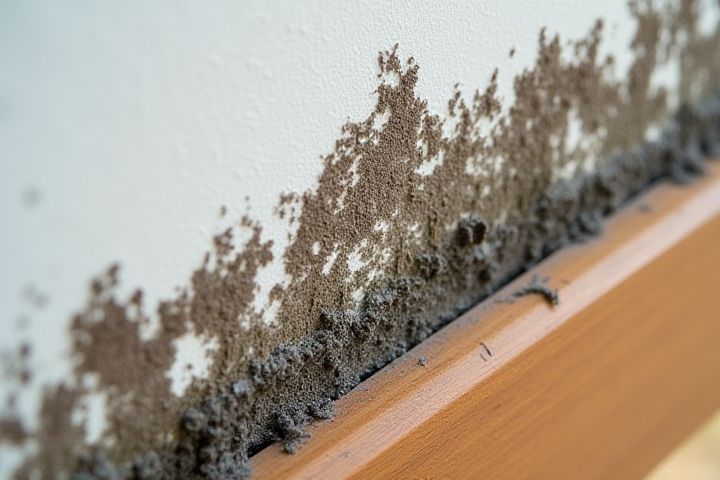
To effectively remove house mold, start by identifying and addressing the moisture source, as damp conditions encourage mold growth. Use protective gear, such as gloves and a mask, when cleaning to avoid health risks from mold spores. A solution of one cup of bleach mixed with a gallon of water can be applied to affected areas, including walls and ceilings, to kill mold. Scrub the area thoroughly with a brush, ensuring that all visible mold is removed, and then allow it to dry completely to prevent regrowth. For larger infestations, or if the mold covers more than 10 square feet, it's advisable to consult a professional mold remediation service to ensure thorough and safe removal.
How To Remove House Mold
Identify mold-prone areas
Identifying mold-prone areas in your home is crucial for effective mold removal and prevention. Start by inspecting high-moisture locations such as bathrooms, kitchens, and basements where humidity levels tend to be elevated. Look for visible signs of mold, including dark spots on walls, ceilings, and around windows, as well as any water damage. Ensure to examine areas around pipes, roofs, and appliances, as leaks often contribute to mold growth, making regular checks essential for maintaining a healthy living environment.
Ensure proper ventilation
Ensure proper ventilation in your home to effectively combat and prevent mold growth. Start by opening windows and doors regularly to allow fresh air to circulate, which reduces humidity levels. Use exhaust fans in high-moisture areas, such as bathrooms and kitchens, to expel excess moisture directly outside. Consider using a dehumidifier to maintain indoor humidity below 50%, providing a less favorable environment for mold spores to thrive.
Use protective gear
When tackling house mold removal, it's essential to prioritize your safety by using appropriate protective gear. Equip yourself with a high-quality N95 respirator mask to filter airborne mold spores and protect your lungs from inhalation. Wear durable rubber gloves to shield your hands from direct contact with mold and any potentially harmful cleaning agents. Additionally, use goggles to safeguard your eyes from irritation caused by mold particles and cleaning solutions, ensuring a safer mold-removal process.
Mix vinegar or baking soda solution
Mixing vinegar or baking soda solutions effectively removes house mold due to their natural antifungal properties. For vinegar, combine equal parts white vinegar and water in a spray bottle; this solution can be applied directly to the moldy surface, allowing it to sit for at least an hour before wiping clean. For a baking soda solution, mix one quarter tablespoon of baking soda with water in a spray bottle, spray it on the affected areas, scrub gently, and then rinse with water. Both methods are safe for your home and environment, making them ideal choices for tackling mold growth efficiently.
Apply and scrub affected areas
To effectively remove house mold, apply a mixture of water and detergent or a specialized mold remover to the affected areas. Ensure you scrub vigorously with a sponge or brush to penetrate the mold colonies, particularly in porous surfaces where mold can thrive. After scrubbing, rinse the surface with clean water and allow it to dry completely to prevent future mold regrowth. Regularly inspect these areas and maintain low humidity levels in your home, ideally below 50%, to create an environment less favorable for mold development.
Fix underlying moisture issues
Identifying and addressing the source of moisture is crucial in removing house mold effectively. Inspect areas such as basements, crawl spaces, and bathrooms for leaks or excessive humidity, as these are common culprits. Once the moisture source is fixed, utilize dehumidifiers or increase ventilation to maintain a drier environment, preventing future mold growth. It's important to monitor humidity levels regularly, aiming for a range between 30-50% to keep mold at bay.
Dry surfaces thoroughly
To effectively remove house mold, prioritize drying affected surfaces thoroughly, as moisture is a key contributor to mold growth. Use dehumidifiers or fans to reduce humidity levels, ensuring surfaces remain below 50% relative humidity. For porous materials like drywall or fabric, consider replacing them, as mold can penetrate deeply. Regularly inspect areas prone to dampness, such as basements or bathrooms, to prevent future mold infestations.
Seal mold-stained areas
To effectively remove house mold, start by sealing mold-stained areas to prevent spores from spreading. Use a mold-resistant sealant or paint that contains antimicrobial agents, ensuring that the surface is clean and dry before application. This will not only create a barrier against future mold growth but also enhance the appearance of your walls. Regularly inspect these areas for any signs of moisture to maintain a mold-free environment in your home.
Utilize a dehumidifier
To effectively remove house mold, you should utilize a dehumidifier to maintain optimal humidity levels, ideally between 30% and 50%. This appliance reduces excess moisture in the air, making it an inhospitable environment for mold spores to thrive. Place the dehumidifier in damp areas such as basements, bathrooms, and kitchens to maximize its impact on mold prevention. Regularly empty the dehumidifier's reservoir and clean its filters to ensure efficient operation and further inhibit mold growth.
Consult professionals for severe cases
When faced with severe mold infestations in your home, consider consulting professionals who specialize in mold remediation. Experts utilize advanced techniques, such as HEPA filtration and chemical treatments, to ensure thorough removal and prevent future growth. According to the Environmental Protection Agency, mold can cause various health issues, making expert intervention crucial in protecting your home and well-being. Engaging a certified mold remediation service typically costs between $500 and $6,000, depending on the severity of the infestation and your location.
